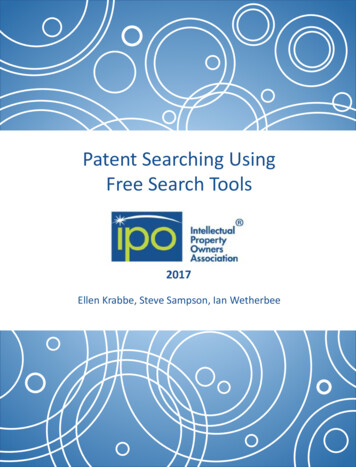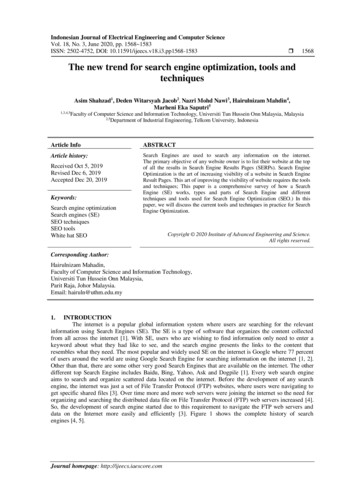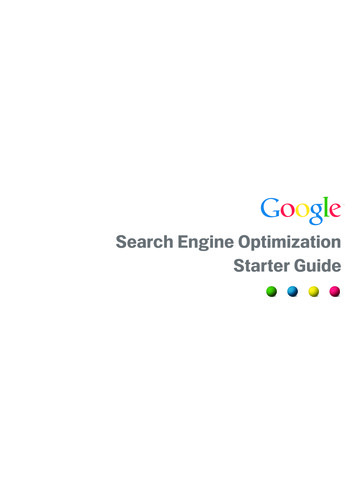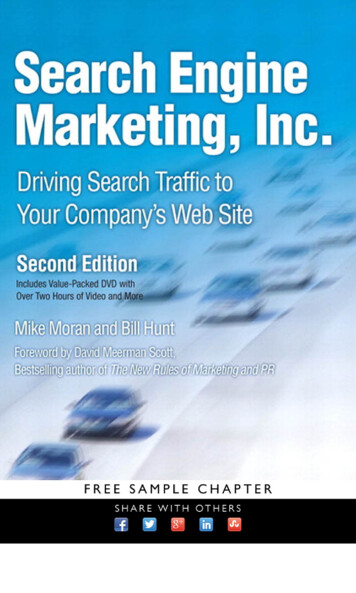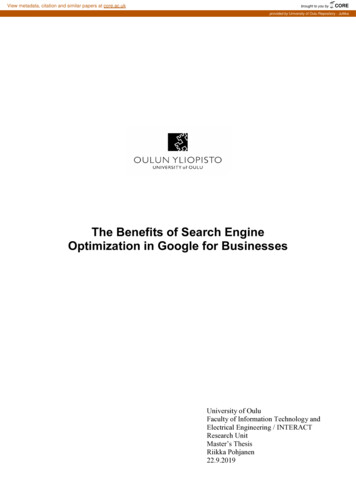
Transcription
View metadata, citation and similar papers at core.ac.ukbrought to you byCOREprovided by University of Oulu Repository - JultikaThe Benefits of Search EngineOptimization in Google for BusinessesUniversity of OuluFaculty of Information Technology andElectrical Engineering / INTERACTResearch UnitMaster’s ThesisRiikka Pohjanen22.9.2019
2AbstractThis study concentrates on search engine visibility and the benefits of search engineoptimization (SEO) in Google for businesses. It seems that search engine visibility hasundeniably an important role in business. Most of the people use internet, more thanhalf of Internet traffic begins with search engines and majority of users search forinformation about goods and services on a regular basis. Google has the largest marketshare of all search engines.SEO has been studied since 1998 when Google was founded. In earlier studies thetopics varied from the basics of SEO to the SEO process in practice and finally to thebenefits of SEO. Only a limited number of information systems theory (IS) studiesfocus on the role of organic listing in search engine visibility. That is why some of thereferences in this literature review represent also general business research.The research question is “What are the benefits of Search Engine Optimization (SEO) inGoogle for businesses?” and the sub questions are: “Why search engine visibility isimportant for businesses?”, “How can business achieve organic search engine visibilityin Google?” and “What is the future of Search Engine Optimization (SEO)?” This is aqualitative empirical study which utilizes eight semi-structured interviews on the matter.The main contribution of this study is to find the differences between academic researchand empirical study findings. The goal is to create a comprehensive understanding aboutthe topic.The main benefits of SEO for businesses are better search engine visibility, morevisitors and better-quality visitors on website and more conversions. It has been noted inmany articles, that SEO alone will not provide us the desired return on investment(ROI). In the empirical results of this study, the interviewees also mentioned betterunderstanding of search engine users, website programming and business as one of thebenefits.KeywordsInternet marketing, search engine visibility, search engine marketing, search engineadvertising, search engine optimization, search engine, Google, Google algorithmsSupervisorPhD, Professor, Marianne Kinnula
3ForewordI chose this topic because I have been working on digital marketing field over eightyears now. All this time digital marketing practices linked to Google search engine havebeen my core competences. My primary goal was to compare academic articles toempirical study findings and find the differences between them. This study reveals,what are the benefits of SEO for businesses today.During the reading process I realized, how academic publications change over time.First, they concentrated on fooling the search engines in order to provide better searchengine results for the chosen websites with the chosen keywords. After that “white hatoptimization” and “black hat optimization” tactics were separated, and the studiesstarted to pay attention also to the user experience in the process. Over time academicstudies made the conclusion that SEO alone cannot create a positive ROI. Only, thecompany’s brand awareness and search engine visibility together with a usable websiteand engaging content create profit for companies. This finding was confirmed by theempirical study as well.I would like to express my special gratitude to my supervisor Marianne Kinnula for thecontinuous support of my master’s thesis study, for her advice, motivation, andknowledge. I must also express my very profound gratitude to my dear husband Veskufor providing me with unfailing support and continuous encouragement.Riikka PohjanenOulu, September 22nd, 2019
4AbbreviationsBRBounce rateCPCCost-per-clickCMSContent Management SystemCTRClick through rateODPOpen Directory ProjectPPCPay-per-clickROIReturn on InvestmentSEASearch Engine AdvertisingSEMSearch Engine MarketingSEOSearch Engine OptimizationSERPSearch Engine Result Page
5ContentsAbstract . 2Foreword . 3Abbreviations . 4Contents . 51. Introduction . 62. Basics of SEO . 82.1 Search or query . 82.2 Search engine . 82.3 Google . 92.4 Google algorithms. 92.5 Search engine visibility . 112.6 Search engine marketing (SEM) . 122.6.1 Search engine advertising (SEA) . 132.6.2 Search engine optimization (SEO) . 132.7 Relations of the core concepts . 143. Search engine visibility . 153.1 Why search engine visibility matters . 163.2 Characteristics of search engine visibility . 173.3 SEA vs. SEO . 183.4 Black hat SEO vs. white hat SEO . 193.5 SEO process in practice . 213.5.1 Fundamental characteristics of SEO process. 213.6 The benefits of SEO for businesses . 274. Research methodology . 294.1 Literature review . 294.2 Selecting research methods . 304.3 Semi-structured interview . 304.4 Data analysis . 325. Empirical research . 335.1 Background . 335.2 SEO process . 355.3 Benefits of SEO . 385.4 The future of SEO . 396. Discussion . 416.1 Why search engine visibility is important for businesses? . 416.2 What are the benefits of SEO in Google for businesses? . 426.3 How can business achieve organic search engine visibility in Google? . 436.4 What is the future of SEO? . 456.5 Summary . 467. Conclusions . 488. References . 51Appendix A. Interview Framework . 56
61.IntroductionThe World Wide Web has become a key player between companies and customers(Pant and Srinivasan, 2010). More than half of Internet traffic begins with a searchengine. An overwhelming majority of users search for information about goods andservices on a regular basis (Dou et al., 2010). Kennedy and Kennedy (2008) haveclaimed that all businesses should have a web presence. Pant and Srinivasan (2010)pointed out that website usability becomes relevant only if the website is discoverable.Google is a remarkable player, because it is the search engine with the largest marketshare (Clemons, 2010).One of the main challenges in digital marketing field is, how to reach the potentialcustomers and lead them to company’s website. The key to being found by the rightpeople at the right time lies in search engines. (Kritzinger and Weideman, 2013.) Peopleuse internet to check features, compare prices and finally even purchasing (Panda,2013). When a person uses search engine, search engine returns a SERP (search engineresult page) in response to each search query. Each SERP contains two lists ofhyperlinks: the organic list and the sponsored list. (Kritzinger and Weideman, 2013; Xuet al., 2012.) With effective search engine advertising or optimization techniques, evenunknown brands can appear ahead of well-known ones in SERP (Dou et al., 2010). Thatis why search engine visibility becomes increasingly important. (Berman and Katona,2013; Klatt, 2013.)In SEA (search engine advertising), companies pay for having links to their websitesdisplayed in the sponsored list of a SERP (Dou et al., 2010). Organic list consists of theresults that Google’s algorithms suggest the most relevant for the user based on theterms they search (Clemons, 2010). The operations which improve website’s organiclist positions are called search engine optimization (SEO) (Jones, 2013, xviii). In SEO,companies strive to push the rankings of their websites higher in the organic searchresults through a variety of SEO techniques or by hiring external SEO consultants to dothat for them (Dou et al., 2010).SEM (search engine marketing) is a concept which in academic research meansimproving website’s visibility in SERP (both, the organic list and the sponsored list) butauthors like Google use this term meaning just for the sponsored list in SERP. In thisstudy I try not to use this concept after the chapter 2 to avoid confusion. Instead I willseparate SEO from SEA and use the term “improving search engine visibility” meaningthe process of improving website’s visibility in SERP.This study focusses on SEO. This topic has been studied starting from 1998 whenGoogle was founded. In earlier studies the topics varied from the basics of SEO (Barryand Charleton, 2009; Berman and Katona, 2013; Dou et. al., 2010; Clemons, 2010;Iskandar and Komara, 2018; Jansen and Spink, 2009; Jones, 2005; Kennedy andKennedy, 2008; Klatt, 2013; Malaga, 2008; Moody and Galletta, 2015; Ortega andAguillo, 2010; Pant and Srinivasan, 2010; Sun and Spears, 2011; West and Valentini,2012; Yang and Ghose, 2010.) to the SEO process in practice (Beldona et al. 2012;Eswarawaka et al. 2017; Gregurec and Grd, 2012; Dick, 2011; Killoran, 2013;Kritzinger and Weideman, 2013; Malaga, 2010; Marszałkowski et al., 2014; Panda,
72013; Sathitwitayakul and Prasongsukarn 2011; Zhang and Cabage, 2017; Wang andZhang, 2011; Wang et al. 2015; Xu et al., 2012.) and finally to the benefits of SEO(Baye et al., 2015; Bhandari and Bansai, 2018; Cui et al. 2007; Ho et. al., 2010;Killoran, 2010; Konidaris and Koustoumpardi, 2018; Malaga, 2007; Tomasi and Li,2015; Wu et al., 2005.)I will address the previous issues in my study. Therefore, the primary research questionis:RQ1.What are the benefits of Search Engine Optimization (SEO) in Google forbusinesses?And the sub questions are: Why search engine visibility is important for businesses?How can business achieve organic search engine visibility in Google?What is the future of search engine optimization (SEO)?This is a qualitative empirical study which utilizes eight semi-structured interviews withpeople who had at least limited experience on the matter. The main contribution of thisstudy is to reveal the differences between academic research and the empirical findings.The goal of this study is to create a comprehensive understanding about SEO and thebenefits businesses can get from it. Another ambitious attempt is to try to forecast thefuture role of search engines and SEO for business operations.The structure of this study is the following. In chapter 2 the core concepts will bedefined. The chapter 3 concentrates on literature review and in chapter 4 the researchmethodology will be presented and explained. Chapters 5 and 6 present and discuss theempirical study and the findings of this study. Finally, in chapter 7 the conclusions ofthis study are summarised. The list of references forms the chapter 8 and the interviewframework of the semi-structured interview is available in appendix A.
82.Basics of SEOThis chapter defines the core concepts of the study: search or query, internet marketing,search engine, Google, Google algorithms, search engine visibility, SEM, SEA andSEO. In the end of this chapter, the relations of the core concepts and the informationsearching process are explained with Figure 1.2.1 Search or queryNowadays, we all as consumers search for things we want to buy (Ravi, 2006).Consumer information search is the stage of the decision-making process whereconsumers actively seek information from both internal and external sources. Internalinformation search involves memory and external information search is anything elsebut memory. (Sun and Spears, 2011.) In the past people made searches mainly offline,but during the past decades, most of the searches have transferred online. The reason forthat is the effective search tools that web provides. Online search tools havesignificantly reduced the time used searching. (Ravi, 2006.) When we talk about searchengine searches, the term query is commonly used as a synonym for search (Bhandari &Bansai, 2018; Clemons 2010; Xu et al., 2012). Today, search represents one of the mostimportant activities for Internet users. An overwhelming majority of users search forinformation about goods and services on a regular basis (Dou et al., 2010). From auser’s perspective, web search engines need to provide relevant and useful results. Websearch engines use dozens of factors in determining how to score relevance and to rankthe retrieved results. Typically, the user has no idea what factors lead to a particularresult being retrieved and ranked. (Jansen and Spink, 2009.)The phenomenon of consumers’ search for information has been studied not only inbusiness studies but also in information systems theories. One of the major theoriesused by economists to explain it is the economics of information search theory. Its basicargument is that consumers search for information if the marginal gains from the searchare higher than the marginal costs. This means for example, compared to the time ittakes, it gives more benefit. (Ravi, 2006.)2.2 Search engineSearch engine is a software, which collects data about websites which are indexed andstored on a database. Search engines may return many millions of documents for eachuser query, but the user only looks at a selected few, so it is very important forcompanies to be on top. (Gregurec and Grd, 2012.) Search engines can be classified intothree sorts: crawler-based search engines, human-powered directories and hybrid searchtools. Modern search engines use crawler or spider programs which create databasesautomatically. A bit old fashioned human-powered directory, also known as “openindex systems”, rely upon manual work. Hybrid search engines utilize both crawlerbased and manual work. (Bhandari and Bansai, 2018.) Before search engines and theirsearch robots we used to have Open Directory Project (ODP), a manually edited webdirectory, also known as DMOZ. ODP arranged millions of selected websites in a
9topical hierarchy. In 2010 ODP had hierarchically arranged more than 48 millionwebsites and over 75,000 editors. Google’s directory service also used to be based onODP data. (Pant and Srinivasan, 2010.)Search engines are valuable, because they locate a vast array of information on a widerange of topics quickly (Kritzinger and Weideman, 2013). Search engines areresponsible for many visitors to a company’s website, especially new customers whosearch for information regarding products and services (Tomasi and Li, 2015). A goodsearch engine analytical tool can help companies to spot those visitors (Panda, 2013).2.3 GoogleGoogle was founded in 1998 by Larry Page and Sergey Brin while they were students atStanford University. The idea behind it was to create a search engine that would“organize the world’s information and make it universally accessible and useful”(Jones, 2013, p. xviii). Google uses crawler or spider programs which create databasesautomatically (Bhandari and Bansai, 2018). Google continuously updates its rankings ofsearch results to generate the most relevant search results, which means for example thatsearch engine result page (SERP) can depend on users’ past clicks. (Baye et al., 2015.)Google’s SERP is a co-listing formed of organic listing and sponsored listing. The twolists are competing against each other for consumers’ attention. (Xu et al., 2012.)Google is the search engine with the largest market share (Clemons, 2010). Google had67% of U.S. search market, followed by Microsoft Bing (19%), and Yahoo (10%) inSeptember 2014 (Zhang and Cabage, 2017). According to Alexa Traffic Rank, in 2011Google.com was the most popular website in the United States as well as in the world,and in May 2011, it was the first website to achieve one billion monthly unique visitors.(Baye et al., 2015.) Besides the search engine, Google had a wide range of businessactivities not related to search already in 2010 (Clemons, 2010).Google’s global share is lowered by a few large countries like China and Russia withdominating local search engines (Baidu and Yandex) (Marszałkowski, Marszałkowskiand Drozdowski, 2014). Under China’s internet sensorship policy, Google websites areblocked in China (“Websites blocked in mainland China,” 2019). Additionally, it hasbeen argued that Google’s lack of market leadership in China is because Englishlanguage–based search engines support Western websites. In China Baidu has beendeveloped specifically for the Chinese market leads and its overall market share is closeto 60%. (Beldona, Lin and Chen, 2011.) In other countries more than 90% searches areserved by Google (Marszałkowski, Marszałkowski and Drozdowski, 2014).2.4 Google algorithmsSearch engines were developed to support the access to the enormous amount ofinformation on the Internet by crawling, retrieving, and presenting relevant informationfor users based upon the engines’ search algorithms (Klatt, 2013). The goal was todesign the algorithms so, that they find the most relevant items for the user based on theterms in their search (Clemons 2010). Modern search engines compile an index ofwords on websites by sending spiders or robots to crawl around sites that are registeredwith that search engine. The search engine algorithm estimates the index according todifferent parameters and then stores the index as part of a database on a web server.
10This index is searched when potential customers type in keywords in search engine’ssearch bar. (Bhandari and Bansai, 2018; Gregurec and Grd, 2012.)The key to Google’s early success was its’ algorithms. The Google algorithms are morecomplex than just analysing who links to whom (Jones, 2013, p. xviii). Google’s MattCutts, a frequent spokesperson on SEO issues, split Google’s over 200 algorithms intotwo general classes (Killoran, 2013):(1)(2)“Trust—of which PageRank is only the most well-known component—anassessment of a site’s authority and reputationRelevance—an assessment of how well a site topically matches a query.”Google’s most original and productive feature of algorithm is perhaps PageRank,introduced by Stanford University doctoral candidates Sergey Brin and Lawrence Pagein 1998 (Killoran, 2013). Google has patented the PageRank algorithm, so it is one ofthe few subjects they discuss openly (Killoran, 2010). PageRank is an algorithm thatcalculates a web metric which shows how reputable a page is according to Google.PageRank takes into consideration the quality and the quantity of the incoming links,with other parameters such as the number of outgoing links per page, the visibility ofthe links etc. PageRank values are on a scale from 0 to 10. (Gregurec and Grd, 2012.)Sites which have developed their link authority over a longer period generally have ahigher PageRank (Dick, 2011). Although the exact algorithms differ across searchengines, major players in the field, like Google and Yahoo, rank and display searchresults by considering the similarity of a website’s content to the users’ query, as well asthe authority of the site (Dou et al., 2010). Search engines’ organic ranking rules arecommonly believed to fairly reflect relevance or relative importance of differentwebsites (Xu et al., 2012).Confirming their importance, or doing any reverse engineering of the Google algorithm,is problematic due to Google keeping the factors and the SERP ranking algorithmsecret. They are the most valuable things for SEO industry, as even Google admits thatif the algorithm was known, then it could be outplayed. (Marszałkowski et al., 2014.)Search engines use continuous as well as drastic updates of their search algorithms.Entering the same query at different times, can produce different SERP rankings, asGoogle modify its algorithm at least 500 times per year (Killoran, 2013). The impact ofthese updates on website traffic is uncertain. Some SEO experts reported traffic drops ofmore than 50 percent in their company while other businesses were not affected.Similarly, the rebuilding of the affected websites is an art. Even experienced SEOprofessionals must find new ways to provide organic visibility due algorithm changes.(Klatt, 2013.)
112.5 Search engine visibilitySearch engine visibility means the presence in SERP. In organizing the SERP, Googleused to place the organic list in a wide column on the left and the sponsored list in anarrow column on the right (and sometimes a highlighted area on the top of SERP aswell) (Xu et al., 2012). In figure 2 the old-fashioned Google SERP is presented.Figure 1. Google SERP for “Marriott Marquis New York on January 6, 2010 (Clemons, 2010).It is important to notice that the SERP of Google is constantly changing. Some of thereferences in chapter 8 were written during the time Google’s search results page waslike figure 1. Today Google’s search result page looks like figure 2 presents.3)1)2)Figure 2. Google Search Results for “Marriott Marquis New York” on May 21, 2019.
12Today a SERP consists of one list of hyperlinks: the sponsored list (number 1 in figure2), which is a list of advertising slots that are sold via auctions, are located on top of thepage and underneath the maximum of ten organic search results (number 2 in figure 2).There usually is a maximum of four ads on top on the search results and moreunderneath the organic search results and next to them a company information windowthat is controlled via free Google My Business tool (number 3 in figure 2), but Googleis testing different kinds of combinations all the time.Some people say that the new design of Google’s SERP causes confusion. The ads seemnow more like the organic search results. Already in 2010, consumers appeared to beconfused about the nature of sponsored search. Some consumers did not notice that thetop lines were labeled “sponsored links” and some did not understand that they weredifferent from organic search results. (Clemons, 2010.) Jansen and Spink (2009) studiedthe effect of integrating sponsored and non-sponsored links within the same SERPlisting. It seemed that it was not clear to the user whether he or she clicked on an add oran organic search result.2.6 Search engine marketing (SEM)In this chapter, the concept of search engine marketing (SEM) is explained. In the subchapters the two SEM embodiments, search engine advertising (SEA) and search engineoptimization (SEO) will be also defined.SEM is a method that uses data observation and marketing research to identify the mostsuitable "keyword" for the website and is also called "keyword advertisement" (Malaga,2007). SEM is a growing strategy that businesses use to improve the visibility of theirwebsite in non-sponsored and sponsored section of SERP. The goal is that the searchengine users end up to the website so the businesses can achieve their informational orcommercial goals. (Barry and Charleton, 2009.) Keyword advertisement entails a lot ofknowledge, such as how to choose keywords, how to use keywords to make websites tobe quickly found by search engines, and how to enhance the website's ranking in searchengines (Chen et al., 2011). SEM provides marketers with higher return on investment(ROI) than traditional Internet marketing. In conventional internet marketing marketerscommence their advertisement through banner ads with certain payment rates. Bannerads have lower ROI compared to SEM because banner ads use an inflexible paymentrate, where the payment remains the same no matter what the respond rate is(Sathitwitayakul and Prasongsukarn, 2011).SEM is a problematic term. In academic studies it means most commonly a type ofonline marketing that improves website visibility in SERP through the SEO and SEApractices (Sathitwitayakul and Prasongsukarn 2011). Some articles as well as authorslike Google and SEO industry use term SEM just for the sponsored list in SERP. In thisstudy I try not to use this concept after this chapter to avoid confusion. Instead I will use“process of improving search engine visibility”.
132.6.1 Search engine advertising (SEA)Search engine advertising (SEA) represents the sponsored section of the SERP. In SEA,also known as sponsored search, companies pay to have links to their websitesdisplayed in the “sponsored section” of a SERP (Dou et al., 2010). The concept of SEAis widely studied (Berman and Katona, 2013; Clemons, 2010; Dou et al., 2010: Jansenand Spink, 2009; Sathitwitayakul and Prasongsukarn, 2011; Xu et al., 2012). Sellingsponsored links is typically the leading revenue stream for search engines, and in somecases, the only one. During the sales process, advertisers submit bids for having theirads placed among the sponsored links, and generally the highest bidders win the mostvisible links, usually on the top of the list. (Berman and Katona, 2013.) Searchadvertising has proven itself also as a successful advertising model for the marketersduring the recent decades (Xu et al., 2012).The SEA strategies such as “cost per click” (CPC) (also known as “pay per click”, PPC)offer a flexible payment rate to the Internet marketers. The payment rate directly relatesto the rate of responses to the actual ads, which is determined by the number of clickson the sponsored links. (Sathitwitayakul and Prasongsukarn, 2011.) Google has movedfrom only “cost per click” which places the highest bidder on top of the SERP, also to“rank-by-revenue,” which places the most profitable bidder on top, from Google’sperspective. The most profitable bidder is usually also the highest-quality bidder,providing the bidder pays “enough” for the use of the bidder’s own trademark as asearch term. Rank-by-revenue has been universally adopted not only by Google but alsoby competitors such as Yahoo! and Bing. (Clemons, 2010.)2.6.2 Search engine optimization (SEO)Organic search results represent the non-sponsored section of the SERP (Dou et al.,2010). The process of improving website visibility in organic search results is referredto as search engine optimization (SEO). SEO is a process of creating a website so that itranks well for chosen keywords within the organic search results of major searchengines (Iskandar and Komara, 2018). SEO is also the process of improving the volumeand quality of traffic to a website from search engines via “organic” search results forselected keywords (Kritzinger and Weideman, 2013). Unlike search advertising, whichrequires you to pay for every click sent to your website from a search engine, trafficsent to your site from a search engine’s organic results is free (Chen et al., 2011).SEO is a series of processes that are conducted systematically for improving the volumeand quality of traffic through search engine to the website. The process adapts a websiteto the working mechanism or algorithms of
advertising, search engine optimization, search engine, Google, Google algorithms Supervisor PhD, Professor, Marianne Kinnula . 3 Foreword I chose this topic because I have been working on digital marketing field over eight years now. All this time digital marketing practices linked to Google search engine have



